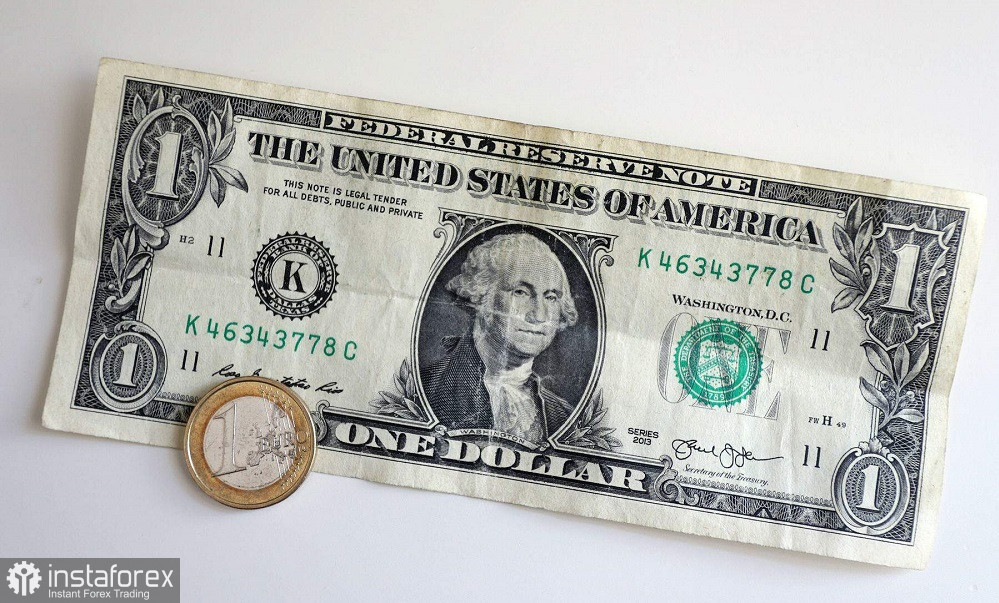The EUR/USD pair sharply surged on Tuesday. The bulls updated nearly a 3-week high and came close to the resistance level at 1.0830 (the lower boundary of the Kumo cloud, coinciding with the Kijun-sen line on the 1D timeframe). If traders manage to settle above this level, the next "destination point" will be the 1.0930 mark (the upper boundary of the cloud on the same timeframe). The greenback is broadly losing ground as North American markets return from an extended weekend (US markets were closed for Presidents' Day).

It is worth noting that the pair is rising against the backdrop of an almost empty economic calendar. During the European session, Eurostat published data on the current account for December. The bloc's adjusted current account surplus rose to 31.9 billion euros in December from 22.5 billion a month earlier. During the US session, the Leading Economic Index (which includes 10 components, from consumer expectations to building permits issued) was released. In January, it ended up in the "red": against expectations of a decline by -0.3%, it reached -0.4%. However, this indicator is secondary of importance, so it has limited impact on the market.
So what is driving the bullish momentum? Amid a semi-empty economic calendar, the market turned its attention to other fundamental factors. For instance, China announced that it has decided to slash their mortgage rate by a record amount. While many experts believe that this move is unlikely to bring immediate relief to the Chinese housing market, the news itself has heightened optimism in the markets. Risk appetite increased, while demand for the safe-haven dollar decreased. The five-year Loan Prime Rate (LPR), which influences borrowing costs for households, was lowered to 3.95%, down from the previous 4.2%. This is the most significant rate cut since its introduction in 2019. Experts believe that this move indicates Beijing's intentions to boost the real estate market, stimulate demand, and improve consumer sentiment. Previous measures did not yield the desired results, hindering sustainable economic growth (also impeded by rising unemployment, especially among youth, and weak sentiments among consumer and business investors).
Markets also reacted to the news that Walmart has optimistically kicked off the corporate earnings season among American retailers. The largest retail company in the US increased its revenue in the fourth financial quarter by 6%. Quarterly revenue grew from $164 billion to $173.4 billion.
However, the dollar is under pressure not only due to increased risk appetite. Dollar bulls require constant information support, as the "threat" in the form of the Federal Reserve's intention to ease monetary policy this year hangs over them. As soon as the greenback gets a "reprieve," it strengthens its positions, but then the "dovish factor" starts to weigh on the dollar again.
For instance, at the end of 2023, the market was confident that the Fed would cut rates in March (the probability of this scenario was estimated at 80%). However, after the January reports and, most importantly, after the January FOMC meeting, the likely date for the first rate cut shifted to May. Mixed data on January inflation, published last week (which reflected a slowdown in the annual CPI but at a slower pace), already raised doubts about the rate cut in May (according to the CME FedWatch Tool, the probability of a rate cut stands at only 35%).
However, the Fed still declared its intention to lower the rate – if not in May, then in June, and if not in June, then in July. In particular, according to economists at the National Bank of Canada, the most likely timing for the first rate cut is July. But at the same time, experts warn: despite the fact that the Fed is "harnessing slowly," it will "ride quickly." According to their forecasts, in the second half of this year, the cumulative easing of policy will amount to 100 basis points.
Probably, for this reason, demand for the dollar has weakened over the past few weeks (according to CFTC data), which generally corresponds to a typical seasonal trading pattern – the rise of the greenback at the beginning of the year is usually followed by its weakness in the second and third quarters.
Therefore, we witnessed the pair's "emotional" rise against the backdrop of an almost empty economic calendar, which is driven by the decline in the US Dollar index amid heightened risk sentiment. The current fundamental conditions are inherently unreliable – on Wednesday, February 21, traders will focus on the minutes of the January FOMC meeting.
You may consider long positions in the EUR/USD pair when the bulls settle above the resistance level at 1.0830 (the lower boundary of the Kumo cloud, coinciding with the Kijun-sen line on the daily chart). In this case, the next target for the upward movement will be the 1.0930 mark – the upper boundary of the Kumo cloud on the same timeframe.





















